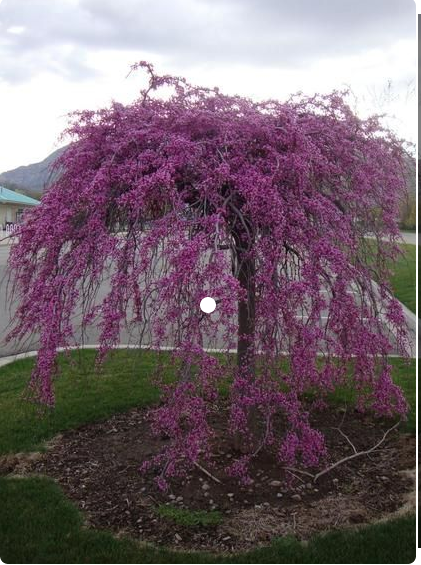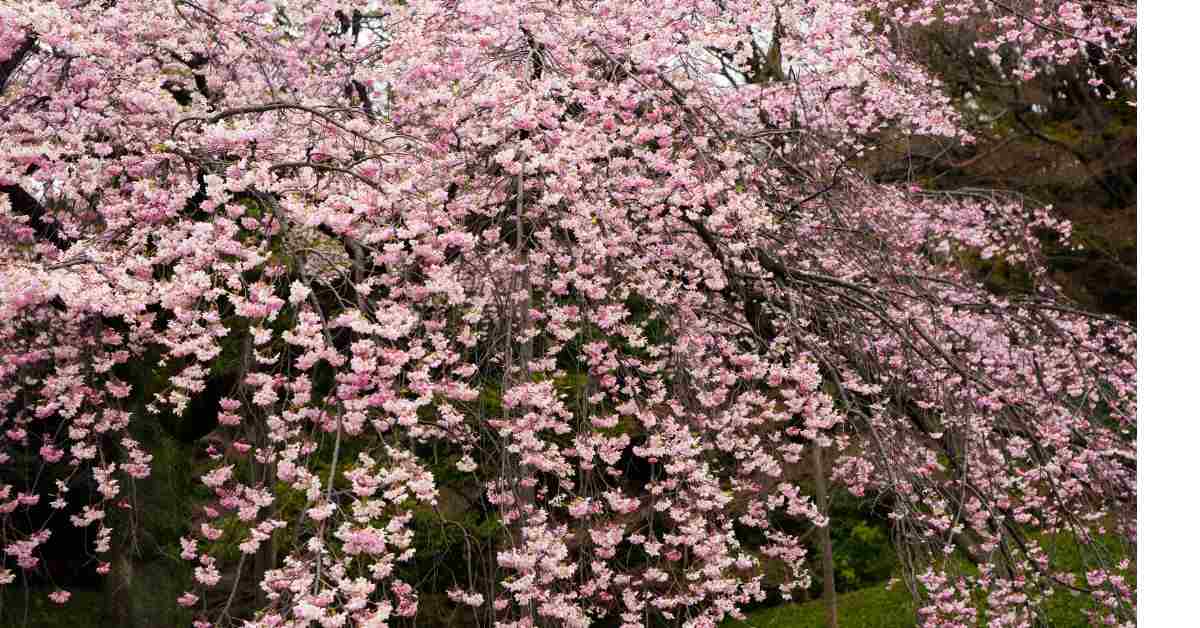In the realm of ornamental trees, few varieties captivate the imagination quite like the dwarf weeping redbud tree. In the spring of 2021, on a visit to the Allens, I came back with a lasting but beautiful memory of a small weeping redbud tree in their front yard, very close to the balcony. That singular experience made me decide on the same variety of ornamental trees in our yard.
The weeping redbud tree, with its graceful cascading branches adorned in stunning magenta blooms, is a petite yet powerful tree that adds an enchanting touch to any landscape.
Join us as we delve into the world of dwarf Dwarf Weeping Redbud trees, exploring their characteristics, care requirements, varieties, and why they deserve a prime spot in your garden.
What are Dwarf Weeping Redbud Trees
Dwarf weeping redbud trees are a compact and ornamental variety of the native Eastern redbud (Cercis canadensis). These trees are known for their graceful weeping habit. The tree features cascading branches adorned with vibrant pink or purple flowers in early spring.
The trees are characterized by their small size, making them perfect for smaller gardens, patios, or even container planting, allowing homeowners to enjoy the beauty of redbuds even in limited spaces.
Dwarf Weeping Redbud Tree Characteristics
- Visual Appeal: Picture delicate weeping branches swaying in the breeze, adorned with vibrant, heart-shaped leaves that transition from reddish-purple in spring to deep green in summer and finally to golden-yellow in fall.
- Size Matters: Unlike its larger counterparts, the Dwarf Weeping Redbud reaches a maximum height of around 6-8 feet, making it perfect for small gardens, patios, or even container planting.
- Bloom Bonanza: Spring heralds the arrival of breathtaking rosy-pink flowers, which blanket the branches before the foliage emerges, creating a picturesque scene straight out of a fairy tale.
Mastering Dwarf Weeping Redbud Tree Care
With proper care and attention, dwarf weeping redbud trees can thrive and delight gardeners with their graceful beauty year after year. The following tips will equip you to nurture these enchanting trees and enjoy their vibrant blooms and weeping branches in your garden.
Planting Your Dwarf Weeping Redbud
The key to success with dwarf weeping redbud tree care begins with proper planting. Follow these steps for a healthy start:
- Choose a sunny location: Select a spot in your garden that receives full sun to partial shade. Dwarf weeping redbuds thrive in sunlight but can tolerate some shade.
- Prepare the soil: Ensure it is well-draining and amend it with organic matter, such as compost, to improve fertility and drainage.
- Dig the planting hole: Dig a hole twice as wide as the root ball but no deeper. Gently loosen the roots before placing the tree in the hole.
- Backfill and water: Fill the hole with soil, tamp it down gently, and water thoroughly to settle the soil around the roots.
Watering and Fertilizing
Proper watering is crucial, especially during the tree’s establishment phase. Here’s what you need to know:
- Water deeply: Provide ample water to moisten the soil but not waterlogged; water deeply at the tree’s base, rather than sprinkling the foliage.
- Mulch to retain moisture: Apply a layer of organic mulch around the base of the tree to help retain moisture and suppress weeds.
- Fertilize sparingly: Dwarf weeping redbuds generally don’t require heavy fertilization. Following the manufacturer’s instructions, apply a balanced fertilizer in spring to promote healthy growth and blooming.
Pruning and Maintenance
Regular pruning helps maintain the health and appearance of dwarf weeping redbud trees. Follow these guidelines to give your tree an attractive and captivating shape:
- Prune in late winter or early spring: Remove any dead, damaged, or crossing branches to improve air circulation and overall tree health.
- Shape the tree: Prune selectively to maintain the desired shape and size of the tree, focusing on removing any overly long or wayward branches.
- Avoid heavy pruning: While dwarf weeping redbuds trees tolerate pruning well, avoid excessive or aggressive pruning, as it can stress the tree and affect flowering.
Pest and Disease Management
Dwarf weeping redbud trees are generally resistant to pests and diseases, but occasional issues may arise. Keep an eye out for signs of pests such as aphids or scale insects, and treat promptly if necessary.
Additionally, ensure proper air circulation and avoid overwatering to prevent fungal diseases like powdery mildew.
Weeping Redbud Tree Landscape Design Ideas
- Focal Point: Plant a Dwarf Weeping Redbud as a standalone specimen to command attention and add a pop of color to your landscape.
- Accent Planting: Pair with evergreen shrubs or ornamental grasses to create contrast and texture in garden beds or along walkways.
- Container Gardening: Showcase the beauty of this tree on patios, balconies, or small urban spaces by planting it in a decorative container, if space is your constraint.
- Plant multiple redbuds: If color parade is your favorite, plant a good number along a pathway or garden border for a stunning display of spring blooms.

Image Credit: Pinterest
Why Choose the Dwarf Weeping Redbud
- Year-Round Interest: From its captivating blooms in spring to its stunning foliage in summer and fall, this tree offers visual interest throughout the seasons. From experience, this is one of the main factors why it is a great choice for Gardeners.
- Space-Saving Solution: Perfect for homeowners with limited garden space, the compact size of the Dwarf Weeping Redbud makes it an excellent choice for urban gardens or small yards. Do you have a little space? Then you are in luck.
- Low Maintenance Beauty: With minimal care requirements and natural resistance to pests and diseases, this tree provides maximum impact with minimal effort.
Exploring 4 Dwarf Weeping Redbud Tree Varieties
If you’re looking to add a touch of elegance and charm to your garden or landscape, dwarf weeping redbuds have an excellent choice of varieties at your disposal. These stunning trees provide beautiful blooms and unique cascading weeping redbud tree varieties that add a dynamic element to any outdoor space. Here are a few to choose from:
1. Lavender Twist Redbud (Cercis canadensis ‘Covey’)
Step into the enchanting world of the Lavender Twist hailed as one of the most captivating dwarf weeping redbud varieties around. Standing proudly at a mere 5 feet tall (though sometimes stretching to 6 feet), with a width that can span up to 8 feet. This popular variety attracts high prices for its weeping branches adorned with lavender-pink flowers in spring.
Picture this: delicate branches gracefully arch downwards, creating a mesmerizing cascade effect that adds a touch of whimsy to any landscape. But wait, it gets even better.
Come early spring, the Lavender Twist transforms into a vision of beauty as it bursts into bloom. Imagine swathes of pink flowers, tinged with a subtle lavender hue, adorning the weeping branches, turning the tree into a living work of art that’s simply impossible to ignore.
And let’s remember those leaves. While they may be smaller in size compared to other varieties, they’re no less charming, boasting heart-shaped elegance that adds to the tree’s allure.
With a mature height of around 6 to 8 feet, Lavender Twist Redbud is well-suited for more miniature landscapes or as a focal point in garden beds. It grows well in zone 5 to 9.
2. Ruby Falls Redbud (Cercis canadensis ‘Ruby Falls’)
Featuring deep burgundy foliage that retains its color throughout the season, Ruby Falls Redbud offers a striking contrast to its pink spring blooms. This compact variety typically reaches 5 to 6 feet, so it is perfect for smaller gardens or as an accent tree.
Ruby Falls features dark maroon-red, heart-shaped leaves and numerous, pea-like, dark rose blooms that appear before the foliage on brilliant red stalks. The leaves change color from burgundy to green toward the end of the summer.
Its small size makes it an ideal choice for small gardens or even container planting. The height of ruby falls reaches 6-8 feet and a spread of 4-6 feet when fully matured,
One of the most captivating features of Ruby Falls Redbud is its spectacular spring display. As temperatures begin to warm, delicate rosy-pink flowers emerge along the gracefully arching branches, creating a breathtaking cascade of color.
Ruby Falls Redbud thrives in USDA hardiness zones 5-9, it can tolerate a wide range of climates across the United States. When it comes to care, this cultivar is relatively low-maintenance, preferring well-drained soil and partial to full sunlight.
3. Merlot Redbud (Cercis canadensis ‘Merlot’)
If you are a lover of wine-red color, Merlot Redbud is your go-to choice. With its wine-red foliage and abundant pink flowers, Merlot Redbud adds a touch of beauty to any landscape.
This dwarf variety grows to around 6 to 8 feet tall and does well in full sun to partial shade, making it adaptable to various growing conditions. Merlot Redbud thrives in USDA hardiness zones 5-9, making it well-suited to a wide range of climates across the United States.
When it comes to care, this cultivar is relatively easy to maintain, preferring well-drained soil and full to partial sunlight. Redbud is healthy and vibrant year after year.
4. Whitewater Redbud Tree
In choosing the right ornamental trees, Whitewater Redbud Tree stands out as an exceptional specimen, boasting a unique blend of features that set it apart from its counterparts. Its dwarf size and weeping growth habit, coupled with its variegated leaves, make it a rare find indeed among similar trees.
Standing at a modest height of 8 feet and spreading to a width of 6 feet, at maturity, it takes on the appearance of a broad vertical pole adorned with numerous long branches that gracefully cascade downward, creating a picturesque silhouette that adds depth and dimension to its surroundings.
Throughout most of the season, Whitewater’s branches are adorned with an enchanting display of green-white leaves. The deep, dark green hues provide a rich backdrop, while the light, snow-like white tones add a touch of beauty to the overall composition.
As spring unfolds, Whitewater unveils yet another spectacle with the emergence of delicate pink flowers on its bare branches. Paired with its weeping form, the flowering period becomes an unforgettable experience, captivating the senses and adding a touch of color to your landscape. This tree can be grown in USDA hardiness zone 5 to 9
Final Thought
Dwarf weeping redbud trees are a charming addition to any of your landscape design ideas, offering beautiful blooms and graceful foliage in a compact package. Whether you’re looking to add color to a small garden or create a focal point in a larger landscape, there’s a variety of dwarf weeping redbuds to suit your needs.
By following the care tips outlined in this guide and exploring creative design ideas, you can enjoy the beauty of redbud trees for years to come.
Enjoy this Article? You May Also Like:
- Choosing the Perfect Redbud: A Comprehensive Guide to Redbud Tree Varieties
- Front Yard Landscaping Ideas: Make a Lasting Impression
- Mastering the Art of Growing Hydrangea Trees: A Step-by-Step Guide
- The Great Divide: Hardwood vs. Softwood – What’s the Difference
- From Seed to Shade: Essential Tips for Lush, Healthy Tree Growth

